Tucked in a dead-end street in a less glamorous corner of Salt Lake City was a Pride event quite different from the huge festival happening miles away.
At Riot! Pride, booths ran along the length of the small street with food vendors, a separate twenty-one-plus space at the end and the Sugar Space arts warehouse converted to a stage for family-friendly performances ranging from drag story time to aerial dance to improv.
An affordable Pride alternative
It was all put together in just 30 days by drag queen Tara Lipsyncki and Equinox Entertainment as a direct counter event to the main Utah Pride Festival. Why? According to Lipsyncki, the big factor was price—to get into the main festival, guests had to pay between $15-30 depending on age.
“So the small queer kids from Delta, Utah or Rock Springs, Wyoming or Pocatello, Idaho that are traveling and have to pay for hotel, gas, and then they have to pay to be in a safe space?” they said. “No, that's not pride. That never has been pride.”

The Utah Pride Center didn’t respond to UPR’s request for comment about Riot! Pride, but they have addressed this year’s financial controversy, in part because affordability was also a problem for vendors.
Booths at the Utah Pride Festival initially cost from $750-$2,000 to apply, non-refundable if they didn’t pick your booth. That’s an increase from last year's price range of $450-$1,200. Businesses also were required to have made a minimum of $20,000 the previous year.
The Utah Pride Center later clarified businesses could share booth spaces or apply for financial assistance, and after a listening forum they created a scholarship process that lowered vendor fees to a minimum of $375.
Comparatively, Riot! Pride booths cost $250 for the weekend, with free options for non-profit or community groups.
The Utah Pride Festival is notably the nonprofit’s biggest source of revenue, funding the festival itself and the Pride Center’s year-round operation costs. They told the Salt Lake Tribune they increased vendor prices instead of ticket prices so more people could participate in the festival.
No matter the reason for increased prices, however, both vendors and guests at Riot! Pride voiced appreciation for having a low-cost or free option.
“I want my kids to come to Pride, but when it costs 30 bucks a person, it’s expensive, and I can’t bring everybody,” said drag king Sir Dylan.
“For those of us that are small businesses and aren’t major corporations, Riot! Pride was a wonderful alternative,” said local vendor Rebel.

Safety without police presence
Another stark difference between the two Prides was security. Utah Pride Festival spent $300,000 on security this year, five times more than last year, due to concerns of increased anti-queer sentiment. Riot! Pride, on the other hand, had a single unarmed person working security at the entrance.
The lack of police presence was mentioned several times as a positive of the event. "Riot! Pride” is even a reference to how pride started as a riot against police.
The event still made safety a priority. Being in a tucked-away space, for one, allowed people to enjoy being outside without being too visible. And during events with kids, like drag story time, the garage doors to the stage area were closed to protect against the possibility of a shooter.
A community coming together
Safety and affordability weren’t what made this event feel like Pride, though—it was the people. Vendors danced along to the music, old friends reunited and new friends were made, and the small but enthusiastic crowd cheered wildly for every performance.

Sir Dylan even got to bring their kids along to watch them perform.
“This is the first year that they’ve ever seen me, and it’s so much fun,” they said. “I had to kind of stop myself from crying just because of the emotions. But it’s really eye opening, and it’s just—it's so fun.”
At the end of the day, after creating a space where people could afford to come and feel safe enough to stay, Riot! Pride was all about community. That was the true highlight for many Pride-goers, including drag king Post-Op Malone.
“I like seeing the community come together,” Post-Op Malone said. “You get the artists that perform, the artists that sell their work, you get to hear about causes you might not otherwise have heard about. And it's just a way of the community coming together and celebrating.”
That’s something Riot! Pride plans to provide again next year, and something hopefully every Pride event, big or small, has in common—that queer people and their loved ones can come together in celebration and joy.



